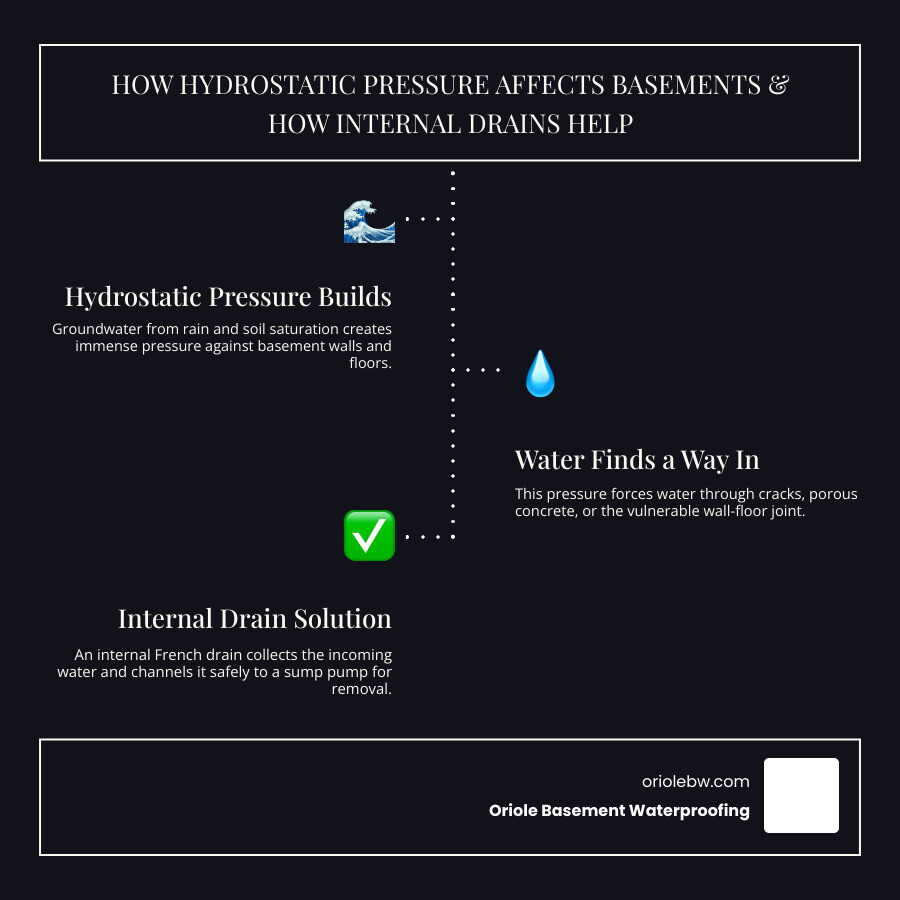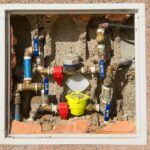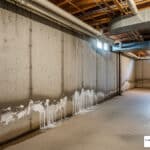Understanding Basement Water Issues in Maryland Homes
An internal french drain is a basement waterproofing system that manages water intrusion by collecting water that enters your basement and directing it to a sump pump for removal. Here’s what you need to know:
What it is: A perforated pipe surrounded by gravel, installed along the interior perimeter of your basement floor
How it works: Collects water at the wall-floor joint and channels it away from your living space
Key benefits: Less disruptive than exterior solutions, protects landscaping, can be installed year-round
Best for: Existing homes where exterior excavation is impractical or too expensive
Picture this: you’re walking down to your basement after a heavy Maryland thunderstorm, and you hear that dreaded sound – water dripping where it shouldn’t be. Maybe you see dark stains creeping up from the floor, or catch that musty smell that makes your heart sink.
You’re not alone. After 70+ years in the basement waterproofing business here in Maryland, we’ve seen thousands of homeowners face this exact moment. The good news? Basement waterproofing is not about stopping water. It’s about managing where it goes.
Here’s the thing most people don’t understand about basements: they’re basically concrete boxes sitting underground, constantly surrounded by water pressure from rain, groundwater, and seasonal changes. This pressure, called hydrostatic pressure, will always find a way in through tiny cracks, porous concrete, or the joint where your wall meets the floor.
That’s where an internal french drain becomes your basement’s best friend. Instead of fighting Mother Nature, this system works with the natural flow of water to keep your basement dry and usable.

Understanding the Internal French Drain: How It Works and Why You Might Need One
When water finds its way into your basement, it’s not just a nuisance; it’s a threat to your home’s foundation, your belongings, and even your family’s health. That’s why understanding effective waterproofing solutions, like an internal french drain, is so crucial for homeowners across Baltimore City, Baltimore County, and Harford County.
What Is an Internal French Drain System?
At its core, an internal french drain is a sophisticated drainage system installed along the interior perimeter of your basement floor. Unlike its exterior counterpart, which aims to stop water before it reaches your foundation, an interior system manages water once it has already entered the immediate vicinity of your basement.
So, how does it work? Imagine a perforated pipe, typically 4 inches in diameter, nestled in a shallow trench beneath your concrete slab, right next to your foundation wall. This pipe is surrounded by washed gravel, which acts as a filter and allows water to flow freely. Any water that seeps through your basement walls, or rises from underneath the floor due to hydrostatic pressure, is intercepted by this system. The water then enters the perforated pipe and is channeled by gravity to a collection point, usually a sump pit, where a sump pump then ejects it safely away from your home.
This differs significantly from an exterior French drain. An exterior drain is buried outside the foundation, often requiring extensive excavation of landscaping, patios, and driveways. Its goal is to divert groundwater and surface water before it can apply pressure to your foundation walls. While both systems are effective, the internal french drain is a less disruptive, often more cost-effective solution for existing homes, especially when exterior excavation is impractical or undesirable. It works by relieving that relentless hydrostatic pressure, giving the water a clear, controlled path to escape rather than allowing it to force its way into your living space.
Key Signs Your Maryland Home Needs an Internal French Drain
Living in Maryland, we’re no strangers to unpredictable weather, from heavy spring rains to winter thaws. These conditions can wreak havoc on basements. Over our 70+ years of experience, we’ve learned to spot the tell-tale signs that an internal french drain might be exactly what your home needs. Don’t wait for a full-blown flood; recognizing these indicators early can save you a lot of headache and expense down the road:
- Water Stains on the Floor or Walls: This is often the most obvious sign. If you see discoloration, dark spots, or rings on your basement floor or lower walls, it means water has been present.
- White, Powdery Efflorescence: This chalky, white residue on your concrete or masonry walls is actually mineral salt deposits left behind after water evaporates. It’s a clear indicator that moisture is constantly seeping through.
- Persistent Musty Smells: That damp, earthy odor isn’t just “old house smell”; it’s often the scent of mold and mildew thriving in a moist environment. Even if you don’t see water, the smell is a strong warning.
- Dampness at the Wall-Floor Joint: This is a common entry point for water. If the area where your basement wall meets the floor feels perpetually damp, or you notice small puddles forming there, your home is likely experiencing hydrostatic pressure.
- Overwhelmed Sump Pump: If you already have a sump pump, but it’s running constantly during rain or can’t keep up, it might be struggling against a larger volume of water than it can handle alone, or perhaps there’s no proper drainage system feeding it.
- Peeling Paint or Wallpaper: Moisture behind finished surfaces can cause paint to bubble and peel, or wallpaper to detach. This indicates water intrusion behind the aesthetic layers of your basement.
Ignoring these signs can lead to more severe problems, including structural damage to your foundation, widespread mold growth (which we can help refer to Raven Mold if there’s no active water intrusion, otherwise we address it as part of the waterproofing solution), and a significant decrease in your property’s value. For more detailed information on identifying these issues, take a look at our guide on 6 Signs You Need to Get Your Basement Waterproofed.
The Professional Installation Process: What to Expect
Installing an internal french drain isn’t a DIY weekend project; it’s a precise, multi-step process that requires expertise to ensure long-term effectiveness. As Marylanders with over 70 years in the business, we understand the local soil conditions and building practices that make proper installation absolutely crucial.
Here’s a general overview of what you can expect when we install an internal french drain system in your Baltimore City, Baltimore County, or Harford County home:
- Preparation and Protection: We start by protecting your home. This means covering floors, sealing off work areas, and moving any furniture to ensure a clean and contained work environment.
- Concrete Breaking: Our team will carefully break up a section of your concrete slab around the interior perimeter of your basement. This is typically done with specialized tools to minimize dust and disruption.
- Trenching and Excavation: Once the concrete is removed, we excavate a shallow trench. The depth and width are carefully calculated to ensure the system sits at the correct level (never deeper than your home’s footings). Installing a drain deeper than the footings is a major mistake that can lead to clay drying out and potential foundation issues.
- Pipe Placement and Gravel: A perforated drainpipe, with its holes facing upwards, is laid in the trench. This orientation is critical for proper water collection. It’s then surrounded by a layer of clean, washed gravel, which helps filter the water and prevents the pipe from clogging with sediment.
- Drainage Membrane (if needed): In some cases, we’ll install a drainage membrane on the interior foundation walls. This membrane directs any water seeping through the walls down into the newly installed drainage system.
- Sump Pit and Pump Connection: The newly installed drainage system is carefully sloped towards a sump pit. This pit houses a high-quality sump pump, which will collect the water and discharge it safely away from your foundation.
- New Concrete Pour: Finally, we pour fresh concrete to patch the removed section of your basement floor, leaving a clean, finished surface that integrates seamlessly with your existing floor.
Why is professional installation so crucial? Because even small errors, like incorrect sloping or improper depth, can compromise the entire system. A properly installed system not only keeps your basement dry but also offers essential foundation protection by managing the water that would otherwise exert damaging hydrostatic pressure on your walls and slab. Our engineering-backed solutions and certified technicians ensure that every installation meets the highest standards for long-term stability and effectiveness.
Is an Interior French Drain Right for You? Pros, Cons, and Expert Advice
Choosing the right waterproofing solution for your home shouldn’t feel overwhelming. After 70+ years of helping Maryland families solve their basement water problems, we’ve learned that the best decisions come from understanding exactly what you’re getting into. Let’s have an honest conversation about internal french drains: the good, the considerations, and when they make the most sense.
The Major Benefits of an Interior System
Here’s what we love about internal french drain systems, and why so many of our Baltimore City, Baltimore County, and Harford County customers choose this solution:
Cost-effectiveness is probably the first thing homeowners notice. When you compare the expense of tearing up your driveway, excavating around your entire foundation, and potentially damaging your landscaping versus working inside your existing basement, the numbers speak for themselves. We’re not saying it’s cheap (quality waterproofing never is), but it’s significantly more budget-friendly than exterior alternatives.
Your yard stays beautiful. We can’t tell you how many customers have breathed a sigh of relief when we explain that their prize roses, new patio, or carefully maintained landscaping won’t be disturbed. Everything happens inside your basement, which means your outdoor spaces remain exactly as you left them.
Weather doesn’t stop us. Whether it’s a snowy February morning or the middle of summer’s heat, we can install your internal french drain system any time of year. No waiting for the ground to thaw or worrying about rain delays; we’re working in your climate-controlled basement.
Less maintenance headaches come with the territory too. Since your system is protected inside your home, you won’t deal with tree roots growing into pipes, soil shifting and crushing components, or outdoor debris clogging things up. It’s installed in what we call the “clear water zone,” away from all the mud and mess that can plague exterior systems.
Potential Drawbacks and Sump Pump Reliance
Now, let’s talk about what an internal french drain doesn’t do, because we believe in straight talk. This system is brilliant at managing water once it’s trying to enter your basement, but it doesn’t prevent your foundation walls from getting wet on the outside. Think of it this way: we’re giving the water a better place to go rather than stopping it at the door.
Your sump pump becomes your best friend, and that’s both good and potentially challenging. These systems rely heavily on a properly functioning sump pump to move collected water away from your home. When your pump is working correctly, it’s like having a tireless guardian watching over your basement. But pumps can fail, and that’s where things get interesting.
Power outages are the biggest concern we hear from customers, and rightfully so. Maryland storms can knock out electricity right when you need your sump pump most. That’s exactly why we always recommend a battery backup system; it’s like having insurance for your insurance. Why Add a Sump Pump? explains more about these critical components and how sump pumps work to keep your basement dry.
Over many years, you might notice some mineral buildup or dust accumulation in the system. It’s not a deal-breaker, but it’s worth knowing that occasional maintenance checks can keep everything running smoothly.
Making the Call: When to Choose an Interior Solution
So when does an internal french drain make perfect sense? In our experience, it’s often the ideal solution for existing homes throughout Baltimore City, Baltimore County, and Harford County. If your house is already established with mature landscaping, hardscaping, or simply a layout that makes exterior excavation a nightmare, this system shines.
We’ve worked on everything from historic rowhomes in Baltimore City where exterior access is nearly impossible, to suburban homes where the cost of exterior work would be astronomical. Sometimes the most practical solution is also the most effective one.
Long-term effectiveness is where these systems really prove their worth. We’ve seen internal french drains we installed decades ago still working perfectly, protecting basements through countless Maryland storms and seasonal changes. That’s the kind of reliability that comes from proper engineering and quality installation.
Our 70+ years of experience have taught us that every basement is unique, but the principles remain the same. We assess drainage patterns, grading issues, humidity levels, and structural concerns to make sure you get a solution that actually solves the problem instead of just treating symptoms.
As Marylanders ourselves, we understand how frustrating basement water problems can be. We’ve helped thousands of families transform their basements from worry zones into valuable, usable spaces. Whether you’re dealing with occasional dampness or standing water after every storm, there’s likely a solution that fits your situation and budget.
Ready to find out if an internal french drain is right for your home? Get a free, no-obligation inspection for your basement and let our experts assess your specific situation. We’ll give you honest advice about what will work best for your home, your budget, and your peace of mind.








